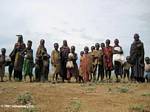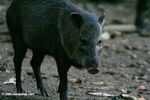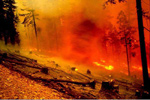FEATURED ARTICLES [Latest news updates]
Could the carbon market save the Amazon rainforest?

|
|
(11/29/2007) The global carbon market could play a key role in saving the Amazon from economic development and the effects of climate change, which could otherwise trigger dramatic ecological changes, reports a new paper published in Science. The authors argue that a well-articulated plan, financed by carbon markets, could prevent the worst outcomes for the Amazon forest while generating economic benefits for the region's inhabitants.
[
Amazon | Deforestation | Impact of climate change | Rainforests]
Carbon credits for forest conservation concept faces challenges:
An interview with Indonesian forest expert Ketut Deddy
(11/27/2007) While environmentalists, scientists, development exports, and policymakers across the political spectrum are ethusiastic about the idea of offsetting carbon emissions by preventing deforestation (a concept known as "avoided deforestation" or Reduced Emissions from Deforestation and Degradation (REDD)), the concept still faces many challenges, especially in implementation. Working to address these issues is SEKALA, an Indonesia-based NGO that was formed in 2005. In an interview with mongabay.com, Ketut Deddy, director of SEKALA, said he is optimistic that REDD can deliver benefits to rural populations while protecting forests and their resident biodiversity.
[
Avoided deforestation | Indonesia | Interviews]
Can wildlife conservation banking generate investment returns?

|
|
(11/27/2007) A commercial venture in the Malaysian rainforest will seek to generate competitive returns on investment by protecting wildlife. The scheme -- signed by the Sabah government and Sydney-based New Forests Pty Ltd -- will establish a wildlife habitat conservation bank to manage the 34,000 ha Malua Forest Reserve on the island of Borneo. Using money from its asset management business, New Forests will to fund rehabilitation and protection of Malua Forest Reserve, a tract of rainforest that supports orangutans and other endangered species. To generate financial returns for investors, New Forests will sell the value of the "forest conservation outcomes" as biodiversity protection credits to palm oil developers, energy firms, and other businesses seeking to provide consumers with environmentally sustainable products including eco-friendly biodiesel.
[
Ecosystem services | Conservation | Malaysia]
Dutch bank arranges carbon-conservation deal in the Amazon rainforest

|
|
(11/27/2007) Dutch bank Rabobank will launch the first-ever carbon credits project in the Xingu region of the Brazilian Amazon, reports The Financial Times. Beginning next month, Rabobank will provide $83,000 to eight soy farms and cattle ranches in the Xingu region in Mato Grosso, the state where most deforestation is presently occurring in the Brazilian Amazon. The money will fund reforestation along waterways and encourage landowners to follow existing environmental regulations.
[
Amazon | Avoided deforestation | Brazil | Happy-upbeat environmental]
Large-scale agriculture 'compromises' forest's ability to recover
An Interview with Dr. Robin Chazdon, tropical ecologist
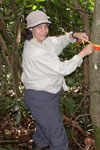
|
|
(11/19/2007) As deforestation of tropical forests continues unhindered, one of the future hopes for these damaged ecosystems is regeneration in secondary forests. Some areas that were once slash-and-burned for cattle ranching or subsistence agriculture have been abandoned, allowing scientists to study the possibility of recovery in the rainforest. If anyone has a clear idea of the potential of secondary forests it is Robin L. Chazdon. Dr. Chazdon, a full professor of Ecology and Evolutionary Biology at the University of Connecticut, has been studying the regeneration of secondary forest for over twenty-five years. She has published over 50 papers on tropical ecology, currently she serves as an active member of the Biotropica editorial board and is a member of the Bosques Project, which measures secondary forest recovery in Northern Costa Rica.
[
Costa Rica | Interviews]
Biodiversity conservation will only work if local people benefit
An interview with Dr. Nina Farwig of BIOTA-East Africa

|
|
(11/19/2007) Biodiversity loss is already having an economic impact in Africa according to a 7-year monitoring project underwritten by Europeans and African governments. The project, known as the Biodiversity Monitoring Transect Analysis in Africa (BIOTA), relies on a network of biodiversity observatories equipped with weather stations, sensors and a monitoring program that includes remote sensing, data on soil fertility and agricultural indicators. Dr. Nina Farwig, a scientist at the Johannes Gutenberg-University of Mainz and a participating member of BIOTA-East Africa, says that conservation efforts in the tropics will only be effective if the local people benefit. Her work with BIOTA shows that even in the absence of extensive forest cover, a patchwork of agricultural landscapes can contribute to the biodiversity conservation.
[
Kenya | Interviews]
7-year old nature guide grows up to become Belize environmental hero
An interview with Colin Young, a Belizean ecologist
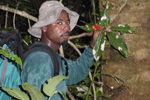
|
|
(11/16/2007) Dr. Colin Young, a native Belizean who, at age seven, started working in as a tour guide in the Community Baboon Sanctuary, says that community management of forests, responsibly-planned ecotourism, and greater emphasis on local science education could go a long way towards smarter and more sustainable use of Belize's natural resources.
[
Belize | Interviews]
Law enforcement key to saving Borneo's rainforests
An interview with Borneo researcher Dr. Rhett Harrison
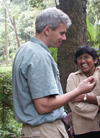
|
|
(11/13/2007) In an interview with mongabay.com, Dr. Rhett Harrison, a Smithsonian Tropical Research Institute (STRI) associate researcher and Secretary for the Asia-Pacific Chapter of ATBC, says that law enforcement could be the key to safeguarding biodiversity contained in Borneo's lowland parks. Harrison says there may be opportunities for conservationists to work with oil palm to developers to ensure that existing forests are not converted for plantations and that palm oil can be produced in a sustainable manner. He also adds that carbon offsets may eventually offer a means to fund conservation and sustainable development efforts in areas that still have standing forest.
[
Borneo | Interviews]
Planned logging of Woodlark Island for biofuels
opposed by islanders and scientists

|
|
(11/12/2007) On Woodlark Island, one-hundred and seventy miles from Papua New Guinea, a struggle is occurring between islanders and biofuel company Vitroplant Ltd. The company is planning to clear much of the island's forest for oil palm plantations to produce biofuels. Vitorplant Ltd.'s contract specifies that they would deforest 60,000 hectares of land for plantations; Woodlark Island is 85,000 hectares in total, meaning over 70% of the island would be converted. Last week, one hundred islanders (out of a total population of 6,000) traveled to the capital of Milne Bay Province, Alotau, to voice their concern over the plans to turn their forested island into plantations.
[
Featured | Biofuels | Palm oil | Papua New Guinea]
Oil palm does not store more carbon than forests
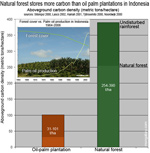
|
|
(11/08/2007) Officials from the Indonesian ministry of agriculture and the palm oil industry are distributing materials that misrepresent the carbon balance oil palm plantations, according to accounts from people who have seen presentations by members of the Indonesian Palm Oil Commission. Ministry of agricultural officials are apparently arguing that oil palm plantations store and sequester many times the amount of CO2 as natural forests and therefore converting forests for plantations is the best way to fight climate change. In making such claims, these Indonesian officials are ignoring data that show the opposite, putting the credibility of the oil palm industry at risk, and undermining efforts to slow deforestation and reign in greenhouse gas emissions.
[
Featured | Biofuels | Palm oil | Indonesia]
Subtle threats could destroy the Amazon rainforest
An interview with Amazon scientist Dr. Carlos Peres

|
|
(11/07/2007) While the mention of Amazon destruction usually conjures up images of vast stretches of felled and burned rainforest trees, cattle ranches, and vast soybean farms, some of the biggest threats to the Amazon rainforest are barely perceptible from above. Selective logging and 6-inch high "surface" fires are turning parts of the Amazon into a tinderbox, putting the world's largest rainforest at risk of ever-more severe forest fires. At the same time, market-driven hunting is impoverishing some areas of seed dispersers and predators, making it more difficult for forests to recover. Climate change -- an its forecast impacts on the Amazon basin -- further looms large over the horizon. Few people understand these threats better than Dr. Carlos Peres of the University of East Anglia. Through affiliations with a roster of universities, Peres has worked extensively in the Amazon on topics ranging from surface fires to wildlife ecology to sustainable development.
[
Amazon | Featured | Interviews | Rainforests]
Proposed gold mine proves controversial in French Guiana rainforest
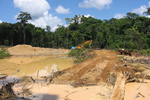
|
|
(11/07/2007) Commercial gold mining threatens a key forest reserve and wetland in French Guiana say scientists who warn that exploitation could pollute rivers with toxic compounds, threaten wildlife, and put indigenous populations at risk. IAMGOLD, a Toronto based mining and exploration company, is seeking to develop gold deposits in the Kaw Mountain region of French Guiana, an overseas department of France located on the northeastern coast of South America. The proposed concession borders Tresor -- a rainforest reserve that houses protected wildlife -- and is close to Kaw swamp, a Ramsar-listed wetland. The Kaw Mountain area is home to 700 plant species, almost 100 species of mammals and 254 species of birds, according to the IUCN.
[
French Guiana | Mining]
An interview with Biopact's Laurens Rademakers:
Carbon-negative bioenergy could drive deforestation
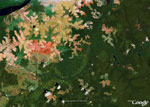
|
|
(11/06/2007) A proposed mechanism for generating carbon-negative bioenergy -- an energy source that reduces atmospheric carbon dioxide levels -- could drive large-scale deforestation in the tropics and undermine efforts to conserve forests for carbon offsets says a biofuel expert. Laurens Rademakers, a natural resource management consultant and co-founder of bioenergy research group Biopact, says that the emerging concept of coupling bioenergy production with carbon capture and storage could trigger conversion of natural forests for energy crop feedstock plantations. Rademakers fears that unless other ecosystem services beyond carbon become bankable, that "bio-energy with carbon storage" (BECS) could undermine efforts to conserve forests through an "avoided deforestation" framework currently being pushed by the World Bank, the U.N., and a coalition of rainforest nations.
[
Bioenergy | Carbon finance | Deforestation]
Climbing Africa's second highest mountain

|
|
(11/05/2007) Mount Kenya, Africa's second highest mountain, is said to be one of the continent's most beautiful hikes. Located less than three hours' drive from Nairobi, Mount Kenya is accessible and makes for a great add-on for fit travelers looking to do more than the standard safari in Kenya. This is my "clinical account" of the trek.
[
Africa | Travel]
Deal reached on U.S. fuel-economy standards
(11/30/2007) U.S. lawmakers reached an agreement to boost vehicle fuel-economy standards for the first time in more than 20 years.
[
United States | Automobiles]
Coral reefs with seasonal temperatures may survive climate change
(11/29/2007) Coral reefs with seasonal temperatures are more likely to survive rising ocean temperatures associated with global warming, reports a new study published in the journal Ecological Monographs. Reefs found in environments with stable but higher temperatures are more susceptible to "bleaching," which can kill corals by causing them to expel the symbiotic algae that provides them with nourishment.
[
Coral reefs | Oceans | Coral reefs and climate change]
New research discredits a $100 billion geoengineering fix to global warming

|
|
(11/29/2007) Scientists have revealed an important discovery that raises doubts concerning the viability of plans to fertilize the ocean to solve global warming, a projected $100 billion venture. The findings are a set back to Planktos, a firm trying to sell carbon offsets derived by salting surface sea waters with iron.
[
Geoengineering | Oceans]
25% of American birds threatened
(11/29/2007) More than one quarter of the bird species found in the United States are imperiled, reports a new survey by the National Audubon Society and the American Bird Conservancy. Overall 178 species in the continental U.S. and 39 in Hawaii are listed on WatchList 2007, which is based on a comprehensive analysis of population size and trends, distribution, and threats for 700 bird species in the U.S.
[
Birds]
Ecomigration: global warming will increase environmental refugees
(11/28/2007) Climate change could spawn the largest-ever migration of environmental refugees due to intensifying droughts, storms and floods, according to a new study published in Human Ecology. Analyzing three case studies -- the US Dust Bowl in the 1930s; Bangladesh since the 1950s; and Hurricane Katrina in 2005 -- Indiana University professor Rafael Reuveny found that while "climate change can spur large population movements, public policy can alleviate the pressures of ecomigration."
[
Environmental refugees | Impact of climate change]
Hope in Bali: the December Meetings on Climate Changes (Opinion)

|
|
(11/28/2007) The fourth, and final, report from the Intergovernmental Panel on Climate Change (IPCC) painted the most irrefutable and sobering picture yet of global warming. Two thousand scientists from over one hundred countries agreed to the statement that "warming of the climate system is unequivocal, as is now evident from observations of increases in global average air and ocean temperatures, widespread melting of snow and ice, and rising global average sea level". The report also stated that it was more than 90% certain that global warming is due to human activity. This report, released last week, will hopefully set the tone for the two week meeting in Bali, Indonesia on climate change and create the rapid and strong responses that are required.
[
Climate change | Jeremy Hance]
U.S. wildlife refuges generate 4x return on investment

|
|
(11/28/2007) National wildlife refuges generate about $4 in economic activity for every $1 the government spends, according to a study released by the U.S. Fish and Wildlife Service Tuesday. The report, titled "Banking on Nature 2006: The Economic Benefits to Local Communities of National Wildlife Refuge Visitation", found that nearly 35 million people visited national wildlife refuges in 2006, supporting about 27,000 private sector jobs and producing about $543 million in employment income, $185.3 million in tax revenue at the local, county, state and federal level, and $1.7 billion in total economic activity.
[
Happy-upbeat environmental | Parks]
Cooking oil, palm oil biodiesel can reduce emissions relative to diesel

|
|
(11/28/2007) A lifecycle analysis of biodiesel by Australia's Commonwealth Scientific and Industrial Research Organization (CSIRO) shows that using palm oil derived from existing plantations can be an effective biofuel feedstock for reducing greenhouse gas emissions relative to conventional diesel fuel. However, palm oil sourced from rainforest and peatlands generating emissions 8 to 21 times greater than those from diesel.
[
Biodiesel | Palm oil]
Photo of the Venomous Gila Monster Getting an X-ray

|
|
(11/28/2007) Dr. Tim Georoff, a veterinarian for the Wildlife Conservation Society's Bronx Zoo, handles this venomous lizard with great care as he prepares this female for an radiograph (X-ray). The Plexiglass housing is part of precautionary measures as the Gila monster's venom is present in its saliva, and is injected into its prey through grooves in the teeth of its lower jaw. Gila monsters hold on tightly and chew, working their neurotoxic venom into the bite."
[
Photos in the news]
Google aims to make renewable energy cheaper than coal

|
|
(11/28/2007) Tuesday Google announced an initiative to develop electricity from renewable energy sources that will be cheaper than electricity produced from coal. The initiative, dubbed RE<C, will initially focus on solar, wind, and geothermal power. Google said it expects to "spend tens of millions on research and development and related investments in renewable energy" and invest "hundreds of millions of dollars in breakthrough renewable energy projects which generate positive returns."
[
Happy-upbeat environmental | Energy]
Shipping industry struggles with pollution
(11/28/2007) Pollution is a rising concern for the cargo shipping industry which carries more than 90% of the world's merchandise by volume, reports The Wall Street Journal.
[
Pollution]
Primate journal offers free online access through year-end
(11/28/2007) The International Journal of Primatology, a prominent peer-reviewed journal on current primatology research, is offering free and unlimited online access until December 31, 2007.
[
Primates]
Photos from Kauai
(11/28/2007) Photos from Kauai.
[
Travel photos]
UN says palm oil destroys forests, indigenous cultures in Indonesia, Malaysia
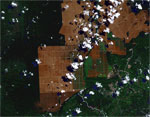
|
|
(11/27/2007) Europe's demand for supposedly eco-friendly biodiesel is fueling destruction of biodiverse rainforests in southeast Asia, warns a new report from the United Nations Development Programme (UNDP). "The expansion of plantation production has come at a high social and environmental price," stated the report. "Large areas of forest land traditionally used by indigenous people have been expropriated and logging companies have often used oil palm plantations as a justification for harvesting timber."
[
Biofuels | Palm oil]
Ground-breaking Amazon rainforest imagery will help monitor deforestation

|
|
(11/27/2007) Scientists have developed a ground-breaking high resolution snapshot of 400,000 square kilometers of Amazon rainforest. The work will help researchers remotely monitor deforestation, according to the Woods Hole Research Center (WHRC). The researchers say remote sensing systems will play a critical role in the development of REDD (Reduced Emissions from Deforestation and Degradation) mechanisms that seek to compensate tropical forest nations for avoiding and reducing deforestation.
[
Amazon | Avoided deforestation | Satellite imagery]
Drought hurts carbon sinks in North America
(11/26/2007) A new system for tracking carbon uptake in North America, shows that deciduous forests along the East Coast (32 percent) and the boreal coniferous forests (22 percent) of northern Canada absorbed the bulk of carbon dioxide emissions between 2000 and 2005, but suggests that climate change may increasingly affect carbon sinks, according to research published in the journal Proceedings of the National Academy of Science.
[
Carbon dioxide]
Guyana's forests offered as massive carbon offset
(11/26/2007) Guyana has offered up the entirety of its remaining forest cover as a giant carbon offset, reports The Independent. Guyana's President, Bharrat Jagdeo, has offered to place the country's extensive rainforests under the control of an international body in exchange for "development aid" and "technical assistance needed to make the change to a green economy."
[
Carbon finance | Guyana]
Vulnerable Australian sea lions further threatened by gillnets and lobster pots

|
|
(11/26/2007) The Australian Sea Lion inhabits only the coastal waters off south and west Australia. Historically, they were hunted almost to extinction by Europeans of the 18th and 19th centuries for their fur and oil. Beginning in 1895, certain populations of the marine mammal were placed under protection until the species gained national protection in 1975. These protections have yet to achieve their goal; Australian Sea Lion populations remain low with some subpopulations in decline. Due to these facts, Australia recently changed their conservation status to 'threatened'.
[
Australia | Marine mammals | Marine conservation]
Palm oil industry announces "eco" standards for production
(11/26/2007) Palm oil producers -- under fire from environmentalists who say the industry is driving the wholesale destruction of biodiverse rainforests in Malaysia and Indonesia -- last week announced a new certification process to ensure greener environmental standards for palm oil, reports Reuters.
[
Certification | Palm oil]
Termites may produce cleaner biofuels
(11/23/2007) Termites may be the key to greener, more effective biofuels, report scientists writing in the November 22 edition of the journal Nature.
[
Biomimicry | Biofuels | Energy]
Is the oil-palm industry using global warming to mislead the public?
(11/23/2007) Today the Jakarta Post published an editorial on the palm oil industry's dubious marketing campaign:
Is the palm oil industry misleading the public?. The op-ed is modified from an article I posted on mongabay on November 8. Here is the un-edited version of the editorial.
[
Biofuels | Palm oil | Indonesia]
Carbon offset returns beat forest conversion for agriculture in Indonesia
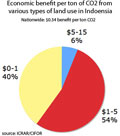
|
|
(11/21/2007) Conversion of forests and peatlands for agriculture in Indonesia has generated little economic benefit while releasing substantial amounts of greenhouse gases into the atmosphere, reports a new study from the the World Agroforestry Centre (ICRAF), the Center for International Forestry Research (CIFOR) and their Indonesian partners. The study, which looked at carbon emissions and land use changes in three Indonesian provinces covering 16 percent of the country, calculated the economic benefits derived from different types of land use and found that Indonesia earns about $0.34 per ton of carbon dioxide emissions.
[
Palm oil | Indonesia]
Amazon rainforest children to get medicinal plant training from shamans
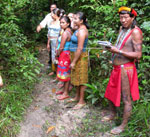
|
|
(11/21/2007) The Amazon Conservation Team (ACT) -- a group using innovative approaches to preserving culture and improving health among Amazonian rainforest tribes -- has been awarded a $100,000 grant from Nature's Path, an organic cereal manufacturer. The funds will allow ACT to address one of the most pressing social concerns for Amazon forest dwellers by expanding its educational and cultural "Shamans and Apprentice" program for indigenous children in the region.
[
Amazon | Indigenous people]
Past climate change triggered wars, population decline
(11/21/2007) Long-term climate change may lead to wars and population decline according to a study published in the journal Proceedings of the National Academy of Sciences (PNAS). The research looked at the cool period known as the Little Ice Age and found that the number of wars increased, famine occurred and the population declined.
[
Impact of climate change]
Subway sandwiches launches first fast-food recycling program
(11/21/2007) Sandwich chain Subway is implementing a recycling program, switching from conventional napkins, cutlery and plastic cups, and reducing gasoline use in an effort to minimize its impact on the environment, according to a report published in The Wall Street Journal.
[
United States]
Rainforest Reserve Established in DR Congo to save bonobo
(11/20/2007) The government of the Democratic Republic of Congo (DRC) has announced the creation of a 11,803-square mile rainforest reserve to protect the habitat of the endangered bonobo, the so-called "peaceful chimp". The reserve is located in the Sankuru region, an area that experienced extensive fighting during the long-running civil war in the Congo.
[
Apes | Congo]
Only 150 vaquita remain
Only 150 individual vaquita, the world's smallest cetacean, remain, according to a new study published in Conservation Biology. The species has been decimated as accidental bycatch in fishing nets in its Gulf of California habitat. Researchers--who say there may be only a two-year window to save the species from extinction--have launched a last-ditch conservation effort.
[
Marine Conservation | Whales]
Physicists join fight to save amphibians from extinction
(11/20/2007) Physicists have joined the fight to save amphibians from extinction by using Optical Coherence Tomography (OCT) to investigate the properties of frogs skin.
[
Amphibian crisis]
Ocean CO2 collector could fight global warming and ocean acidification
(11/20/2007) Researchers have proposed a geoengineering solution to global warming that involves building a series of water treatment plants that enhance the ability of the ocean to absorb carbon dioxide from the atmosphere by removing hydrochloric acid from seawater by electrolysis.
[
Geoengineering | Oceans]
Indonesia will need 7 years to stop illegal logging
(11/16/2007) Indonesia will take seven years to stop illegal logging and deforestation, said the country's minister of forestry.
[
Indonesia | Logging]
New system tracks CO2 emissions of 50,000 power plants worldwide

|
|
(11/14/2007) A new online database allows users to track carbon dioxide (CO2) emissions of 50,000 power plants worldwide. The system, called CARMA--Carbon Monitoring for Action, was developed by the Center for Global Development (CGD), an policy and research group. The research team, led by David Wheeler, hopes the database will help "speed the shift to less carbon-intensive power generation -- with the objective of minimizing global warming." CGD says that climate change will hurt poor people in developing countries "first and worst".
[
Carbon dioxide | Energy | Pollution]
86% of sea turtle species threatened with extinction

|
|
(11/14/2007) Marine turtles have thrived for more than 100 million years. But only the last few hundred years have given the huge, spectacular, prehistoric reptiles serious trouble. And that's where people like Earl Possardt, an international sea turtle specialist with the U.S. Fish and Wildlife Service, come in. Possardt is part of a bigger effort to rescue what remains of seven species of an animal that has managed, sometimes against formidable odds, to make it all the way into the 21st century.
[
Sea turtles | Marine conservation]
In the Amazon, primary forest biodiversity tops that of secondary forest, plantations
(11/12/2007) Plantations and secondary forests are no match for primary Amazon rainforest in terms of biodiversity, reports the largest ever assessment of the biodiversity conservation value in the tropics. Writing in the current issue of the journal Proceedings of the National Academy of Sciences (PNAS), a team led researchers from the University of East Anglia (UEA) and Brazil's Goeldi Museum found that 25 percent of all species were never found outside native primary forest habitat. For groups like trees, birds, leaf-litter amphibians, and lizards the percentage of species restricted to primary forest habitat was even higher at 40-60 percent.
[
Amazon | Biodiversity]
Greenwashing the palm oil industry
(11/12/2007) A new report from Greenpeace alleges that members of the Roundtable on Sustainable Palm Oil -- an industry-driven initiative to clean up palm oil production -- are using palm oil derived by clearing endangered rainforests and draining carbon-rich peatlands on the Indonesian island of Sumatra. Tracing palm oil back to its source plantations in Riau, the report found that Nestle, Procter & Gamble, and Unilever - are sourcing their palm oil from suppliers who are responsible for forest destruction. Palm oil is used in products as diverse as candy bars, cosmetics, and biodiesel..
[
Palm oil | Indonesia]
Sun bear gets 'vulnerable' listing due to deforestation, poaching
(11/12/2007) The sun bear, the world's smallest bear, has been added to the global list of species threatened with extinction, said the World Conservation Union.
[
Endangered species | Wildlife]
China begins blocking river for second largest dam
(11/12/2007) China began damming the Jinsha River for its biggest hydroelectric project after the Three Gorges Project, reports Chinese state media.
[
China | Dams]
Mongabay talking with OpenRoad.TV
(11/11/2007) A couple weeks ago I spoke with the folks over at OpenRoad.TV about mongabay.com, Madagascar, why I live in California, and the origin of my name. OpenRoad.TV, which bills itself as a "Traveler's Video Guide to the American West", is a travel web site and community co-founded by Doug McConnell, Carl Bidleman, and Jim Wirth of Bay Area Backroads, a television show that has highlighted special places in the western United States for more than 15 years. The segment was filmed in a local San Francisco Bay Area park and is part of OpenRoad.TV's new video blog series called Life Outside the Box.
[
OpenRoad.TV]
An interview with tiger expert Dr. K. Ullas Karanth:
How to save tigers in India

|
|
(11/08/2007) Over the past century the number of tigers in India has fallen from about 40,000 to less than 4,000 (and possibly as few as 1,500). Relentless poaching and clearing of habitat for agriculture have been the primary drivers of this decline, though demand for tiger skins and parts for "medicinal" purposes has become an increasingly important threat in recent years. However the news is not all bad. Research published last year showed that if protected and given sufficient access to abundant prey, tiger populations can quickly stabilize. With India's large network of protected areas and continued funding from conservation groups like the Wildlife Conservation Society, the findings provide hope that tigers can avoid extinction in the wild.
[
Tigers | Interviews | India]
Asia's tigers could get big boost from small conservation efforts
(11/05/2007) Small changes to the management of wildlife reservers in India, Bangladesh, Bhutan, and Nepal could dramatically boost endangered tiger populations, reports a new study published in the journal Biological Conservation.
[
Tigers | Wildlife]
NPR feature on the Brazilian Amazon [external]
(11/05/2007) Today National Public Radio's (NPR) "All Things Considered" broadcast will be on Mato Grosso, Brazil. The emphasis will be on the Tanguro Research Center, which is run by the Environmental Research Institute (IPAM) -- an extension of Woods Hole Research Center. Aliança da Terra, an innovative Brazilian NGO working to develop sustainable ranching and agriculture in the Amazon, was responsible for bringing this institute to the southern Amazon and data produced by IPAM is being applied in Aliança da Terra's field work. Woods Hole Research Center scientist Dan Nepstad and Aliança da Terra founder John Cain Carter will be speaking. During the interviews the Amazon was experiencing some of the worst fires on record.
[
Amazon]
New peccary species discovered by embattled Amazon scientist
(11/04/2007) A new species of peccary has been discovered in the Amazon rainforest by a scientist recently charged with biopiracy by the Brazilian government. The animal, called the giant peccary or Pecari maximus, is described in the October 29 issue of the journal Bonner zoologische Beitrage. It apparently only lives in the Rio Aripuana river basin in Brazil. The species was spotted by Dutch biologist Marc van Roosmalen of the University of Leiden during field surveys in the region. For Dr van Roosmalen, who previously discovered a new species of porcupine and seven new kinds of primates in the region, the discovery may be a sort of vindication of his work.
[
Amazon | Species discovery]
Central Africa's 'Most Beautiful Waterfall' to be destroyed
(11/04/2007) One of Africa's most dramatic waterfalls will be destroyed by a hydroelectric project in Gabon, according to reports from a Gabonese NGO and the Inter Press Service (IPS).
[
Dams | Gabon]
California fires release 8M tons of CO2
(11/01/2007) Southern California wildfires released 7.9 million metric tons of carbon dioxide in just the one-week period of October 19-26--the equivalent of about 25 percent of the average monthly emissions from all fossil fuel burning throughout California--according to researchers at the National Center for Atmospheric Research (NCAR) and the University of Colorado at Boulder.
[
Forest fires | United States]
Most popular news articles for October
(11/01/2007) The massive forest fires in the Amazon were a popular topic in October despite little Western media attention.
[
Most popular]

















